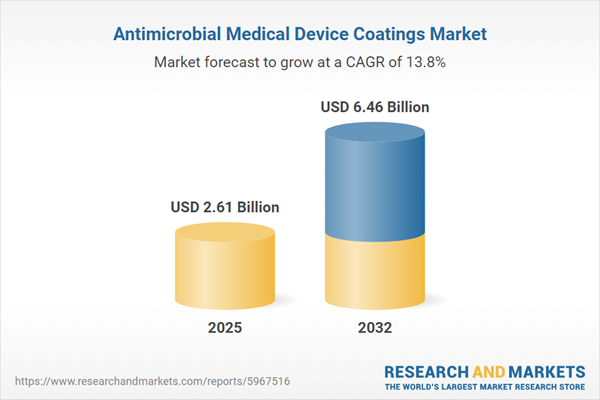Speak directly to the analyst to clarify any post sales queries you may have.
The Antimicrobial Medical Device Coatings Market is undergoing rapid transformation due to evolving infection control needs, regulatory changes, and advanced coating technologies. Senior decision-makers are prioritizing robust solutions to improve patient outcomes and operational resilience across diverse healthcare settings.
Market Snapshot: Antimicrobial Medical Device Coatings Market Growth and Dynamics
The Antimicrobial Medical Device Coatings Market grew from USD 2.29 billion in 2024 to USD 2.61 billion in 2025. It is forecasted to continue expanding at a CAGR of 13.83%, reaching USD 6.46 billion by 2032. This strong momentum is fueled by increasing demand for infection-resistant devices, regulatory alignment, and the adoption of innovative coating chemistries. Hospitals, ambulatory surgical centers, and home healthcare service providers are adopting these solutions to meet heightened safety expectations and comply with new clinical standards.
Scope & Segmentation
- Coating Technologies: Antibiotic eluting systems, nitric oxide releasing technologies, silver-based surfaces
- Application Areas: Catheters, orthopedic implants, surgical instruments, wound dressings
- End Users: Hospitals, ambulatory care centers, home healthcare providers, diagnostic centers
- Material Types: Ceramics (alumina, zirconia), metals (stainless steel, titanium), polymers (thermoplastic, thermoset)
- Pathogen Targeted: Bacterial (gram-negative, gram-positive), fungal (mold, yeast), viral (enveloped, non-enveloped)
- Geographic Coverage: Americas (United States, Canada, Mexico, Brazil, Argentina, Chile, Colombia, Peru), Europe, Middle East & Africa (UK, Germany, France, Russia, Italy, Spain, Netherlands, Sweden, Poland, Switzerland, UAE, Saudi Arabia, Qatar, Turkey, Israel, South Africa, Nigeria, Egypt, Kenya), Asia-Pacific (China, India, Japan, Australia, South Korea, Indonesia, Thailand, Malaysia, Singapore, Taiwan)
- Key Companies: 3M Company, BASF SE, Dow Inc, Akzo Nobel N.V., Evonik Industries AG, Koninklijke DSM N.V., Microban International LLC, Surmodics, Inc., Covalon Technologies Ltd, SteriMedix LLC
Key Takeaways for Senior Decision-Makers
- Antimicrobial coatings are vital in reducing healthcare-associated infections, delivering localized pathogen control while preserving device integrity.
- Innovation in smart coatings, such as nitric oxide release and multifunctional silver-nanoparticle formulations, is enhancing performance and tailored pathogen defense.
- Providers are demanding solutions that integrate seamlessly into established sterilization processes, facilitating broad adoption without disrupting workflows.
- The sector is witnessing increasing collaboration between medical device leaders and specialty material innovators, accelerating commercialization of new platforms.
- Regional strategies vary: U.S. and North America emphasize localized production and supply chain security; Asia-Pacific benefits from domestic alliances and high orthopedic demand; EMEA shows mixed adoption paces due to regulatory harmonization and funding variability.
- Emerging home healthcare and outpatient settings are driving the need for robust, durable coatings with responsive monitoring capabilities.
Tariff Impact on Supply Chains and Strategic Sourcing
U.S. tariff adjustments starting in 2025 have created sourcing pressures for imported specialty materials, including advanced nanoparticles and proprietary polymers. As a result, device manufacturers are increasingly investing in domestic partnerships, local manufacturing, and flexible procurement contracts to mitigate cost volatility. Some are recalibrating portfolios to focus on higher-margin coatings that can absorb tariff impacts, using advanced formulation and production strategies to sustain market position.
Methodology & Data Sources
This report utilizes structured interviews with industry experts, comprehensive reviews of peer-reviewed literature and regulatory filings, and in-depth analysis of supply chain trends. Data triangulation and industry panel review underpin the validation process, ensuring insights are both credible and actionable.
Why This Report Matters
- Equips leaders with a holistic view of innovation, regulatory trends, and supply chain risks across the antimicrobial medical device coatings landscape.
- Facilitates strategic decisions on product development, investment, and market entry by providing clear segmentation insights and actionable intelligence.
- Supports rapid response to emerging challenges—such as tariff volatility and evolving clinical needs—enabling organizations to safeguard resilience and growth.
Conclusion
As infection control becomes central to global healthcare delivery, antimicrobial coatings are redefining device safety and performance standards. This report empowers leadership with the knowledge to drive innovation, ensure compliance, and capture emerging opportunities in a dynamic market.
Additional Product Information:
- Purchase of this report includes 1 year online access with quarterly updates.
- This report can be updated on request. Please contact our Customer Experience team using the Ask a Question widget on our website.
Table of Contents
3. Executive Summary
4. Market Overview
7. Cumulative Impact of Artificial Intelligence 2025
Companies Mentioned
The companies profiled in this Antimicrobial Medical Device Coatings market report include:- 3M Company
- BASF SE
- Dow Inc
- Akzo Nobel N.V.
- Evonik Industries AG
- Koninklijke DSM N.V.
- Microban International LLC
- Surmodics, Inc.
- Covalon Technologies Ltd
- SteriMedix LLC
Table Information
| Report Attribute | Details |
|---|---|
| No. of Pages | 186 |
| Published | November 2025 |
| Forecast Period | 2025 - 2032 |
| Estimated Market Value ( USD | $ 2.61 Billion |
| Forecasted Market Value ( USD | $ 6.46 Billion |
| Compound Annual Growth Rate | 13.8% |
| Regions Covered | Global |
| No. of Companies Mentioned | 11 |









